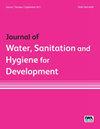低收入和中等收入国家儿童不安全的粪便处理做法及其与儿童腹泻的关系:系统回顾和荟萃分析
IF 1.4
4区 环境科学与生态学
Q3 WATER RESOURCES
Journal of Water Sanitation and Hygiene for Development
Pub Date : 2022-10-25
DOI:10.2166/washdev.2022.040
引用次数: 0
摘要
在家庭环境中,对儿童粪便的不当处理可能是一种重要的污染物,增加了儿童接触的高风险。因此,本研究的目的是汇集现有的证据,证明在低收入和中等收入国家,安全的儿童粪便处理方法的普遍程度及其与报告的儿童腹泻的关系。检索PubMed、Science Direct、Cochrane Library数据库、Ovid Medline、谷歌Scholar以及其他研究的参考文献。搜索仅限于发表在英语文献中的研究。两名独立审稿人使用适当的工具对选定的研究进行批判性评估。使用Stata version 16进行分析。20项研究中儿童粪便不安全处理的总发生率为52.63% (95% CI: 0.43-0.62)。总的来说,荟萃分析发现,不安全的处理做法使腹泻的风险增加了4% (OR: 1.04, 95% CI: 0.84-1.24)。在亚组分析中,大洋洲儿童粪便的不安全处理降低了腹泻的风险(OR = 0.75, 95% CI = 0.62-0.88),而在亚洲则增加了腹泻的风险(OR = 1.33, 95% CI = 1.25-1.41)。总之,不安全的儿童粪便处理方法的流行率很高。不安全的儿童粪便处理方法与腹泻之间没有显著关联。本文章由计算机程序翻译,如有差异,请以英文原文为准。
Unsafe fecal disposal practices in children and the nexus with childhood diarrhea in low- and middle-income countries: a systematic review and meta-analysis
In household environments, the improper handling of children's feces can be a significant contaminant, raising a high risk of child exposure. Thus, the objective of this study was to pool the available evidence on the prevalence of safe child feces disposal practices and their association with reported childhood diarrhea in low-income and middle-income countries. PubMed, Science Direct, Cochrane Library databases, Ovid Medline, Google Scholar, and references of other studies were searched. The search was limited to studies published in English-language literature. Two independent reviewers used an appropriate tool to critically appraise the selected studies. Stata version 16 was used for the analysis. The pooled prevalence of unsafe disposal of children's feces among 20 studies was 52.63% (95% CI: 0.43–0.62). Overall, the meta-analysis found that unsafe disposal practices insignificantly increased the risk of diarrhea by 4% (OR: 1.04, 95% CI: 0.84–1.24). In the subgroup analysis, unsafe disposal of children's feces decreased the risk of diarrhea in Oceania (OR = 0.75, 95% CI = 0.62–0.88) and increased in Asia (OR = 1.33, 95% CI = 1.25–1.41). In conclusion, the prevalence of unsafe child feces disposal practices was high. There was no significant association between unsafe child feces disposal practices and diarrhea.
求助全文
通过发布文献求助,成功后即可免费获取论文全文。
去求助
来源期刊

Journal of Water Sanitation and Hygiene for Development
WATER RESOURCES-
CiteScore
3.10
自引率
11.80%
发文量
58
审稿时长
16 weeks
期刊介绍:
The Journal of Water, Sanitation and Hygiene for Development is a peer-reviewed journal devoted to the dissemination of high-quality information on the science, policy and practice of drinking-water supply, sanitation and hygiene at local, national and international levels.
 求助内容:
求助内容: 应助结果提醒方式:
应助结果提醒方式:


